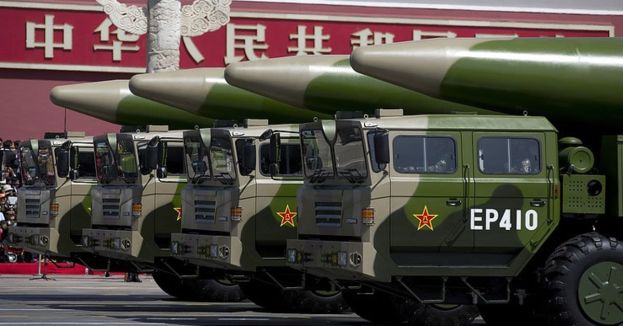When asked if the U.S. has the capabilities to match China's missiles, Aquilino responded with a resounding "zero." This revelation raises serious concerns about America's ability to deter war and win if deterrence fails.
The Pentagon reports that China currently has over 1,250 ground-launched theater-range ballistic and cruise missiles that can target U.S. interests across the Indo-Pacific. In fact, China tested more ballistic missiles in 2021 than the rest of the world combined.
China's missile force is a key component of its "anti-access/area denial" strategy, which aims to push U.S. forces out of the first and second island chains by demonstrating its ability to strike U.S. forces within these areas.
Recent war games have shown the effectiveness of China's counter-intervention strategy. In a hypothetical battle for Taiwan, China's precision salvos could devastate U.S. military bases and Navy ships as far out as Guam, resulting in significant losses for U.S. air and seapower.
WATCH TRUMP: EUROPE HAS OPENED IT'S DOORS TO JIHAD![]()
A scenario developed by the Center for Strategic and International Studies (CSIS) revealed that the U.S. would lose hundreds of aircraft and see bases on Guam destroyed in just four weeks of fighting. This would force U.S. commanders to rely solely on expensive, high-end air and naval forces, severely limiting their ability to counterattack.
WATCH DUKE PROFESSOR: STUDENTS VIEWING THE WORLD AS OPPRESSOR VS. OPPRESSED![]()
The missile gap between the U.S. and China has been decades in the making. The Intermediate-Range Nuclear Forces (INF) treaty, which prohibited the U.S. and Russia (but not China) from deploying certain types of ground-launched missiles, hampered America's ability to develop theater-range missiles.
KEVIN SPACEY'S DARK SECRETS EXPOSED IN NEW DOCUMENTARY SERIES![]()
After Russia was found to be in violation of the treaty, the Trump administration withdrew from it in 2019. However, little progress has been made in offsetting China's missile capabilities since then. It will require an act of Congress to level the playing field in long-range strike capabilities.
IDIOT ALERT: CEO PRAISES RADICAL PROTESTERS, FACES IMMEDIATE BACKLASH![]()
To address this gap, Senator Joni Ernst, a Republican from Iowa, has introduced the Rings of Fire Act of 2023. This legislation would require the Pentagon to develop a strategy for countering China's missile advantages in the Indo-Pacific.
BIDEN AND MARK HAMILL'S "STAR WARS DAY" VIDEO: A GALACTIC SUCCESS OR EPIC FAIL?![]()
The strategy would assess the gaps in U.S. theater-range strike capabilities and identify the military requirements to close them. It would also involve developing concepts for operating these fires and identifying key allies and basing locations to deploy them.
TUBERCULOSIS OUTBREAK: HEALTH EMERGENCY DECLARED IN CALIFORNIA, ARE YOU AT RISK?![]()
The goal is to field credible and affordable combat power across the Pacific, reducing China's homefield advantage.
An effective Indo-Pacific missile strategy should take advantage of geography. While China deploys missiles on its mainland, the U.S. can deploy them across the region with the support of partners and allies. Countries like Japan and the Philippines could host shorter-range systems, while longer-range systems could be deployed to northern Australia, the Pacific Islands, and Alaska.
ELITE UNIVERSITIES FACE A NEW CRISIS: OUTRAGED PARENTS ![]()
This would establish "rings of fire" that provide a defense-in-depth across the Pacific.
Currently, the U.S. has some shorter-range capabilities in its arsenal, such as Precision Strike Missiles. However, the Biden administration has failed to budget for these capabilities, leaving $1 billion of unfunded missile requirements for the Indo-Pacific.
OBAMA PROMISED THIS WOULD NEVER HAPPEN, YET HERE WE GO!![]()
This lack of urgency and seriousness in implementing the National Defense Strategy, which identifies China as the biggest challenge, is concerning. Additionally, the U.S. has no intermediate-range systems under development, while China's Dongfeng-26 missile can reach up to 4,000 km, including Guam.
To close the missile gap, it is not just the responsibility of the United States. An Indo-Pacific missile strategy should involve leveraging allies and partners to join in the development and production of these systems. This would reduce costs for the U.S. taxpayer and enhance interoperability for the warfighter.
Australia has already expressed a willingness to modernize its guided weapons programs and manufacture long-range weapons domestically. Under the AUKUS agreement, the U.S. can collaborate with its closest allies in the region to accelerate the development and production of next-generation missile technologies.
Building these "rings of fire" in coordination with allies would enhance deterrence and create challenges for Chinese military planners. Closing the missile gap and shifting the regional balance of power in favor of the U.S. would make Xi Jinping think twice before attempting to take Taiwan by force.
However, even if the Rings of Fire Act passes and the Pentagon develops a coherent strategy for fielding precision fires, it will require sustained oversight to make this vision a reality.
Restoring deterrence in the Indo-Pacific demands dedicated attention from the highest levels of the Pentagon, State Department, and Congress. Given the growing risks of great power conflict in the region, there is no time to waste.








 Discover alternative ideas that will make you think
Discover alternative ideas that will make you think Engage in mind bending debate
Engage in mind bending debate Earn points, rise in rank, have fun
Earn points, rise in rank, have fun


